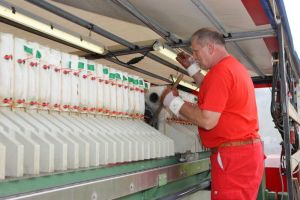Phosphorus is a vitally important element, finite, and irreplaceable. Worldwide resources that may be exploited efficiently will suffice for another 100 years. KIT scientists have developed a process for the recovery of phosphorus that is presently being applied at the sewage treatment plant of Neuburg an der Donau. In cooperation with the MSE company from Karlsbad-Ittersbach, KIT now wants to extend a mobile sludge dehydration facility with this process to recover phosphorus from the sludge concentrate.
Presently, experiments are being conducted in cooperation with MSE (Mobile Schlammentwässerungs GmbH), a subsidiary of EnBW Kraftwerke AG, to characterize the different types of wastewater separated from the solids under centrifugal force. This is “an important step prior to short- and long-term experiments that will follow,” explains Dr. Rainer Schuhmann, Head of the KIT Competence Center for Material Moisture (CMM).
By means of this new technology, “sewage treatment plants, the sludge residues of which are dehydrated on a mobile scale can also fulfill their obligations,” emphasizes the project manager of MSE, Dr. Rudolf Turek. And these requirements are getting stricter: The federation is presently discussing an obligation to recover a certain percentage of phosphorus based on a draft submitted by the Federal Ministry of the Environment in April 2011. Scientists as well as industry and sewage treatment plant operators are planned to be obliged to look for possibilities of phosphorus recovery.
Phosphorus is recovered by means of a process developed by KIT. Scientists of the Environmental Technology Division of CMM recover the phosphate dissolved in the wastewater phase by crystallization. This simple and effective principle, Rainer Schuhmann explains, “yields a high-quality fertilizer that contains phosphorus and other plant nutrients and is highly available to plants.”
Being “The Research University in the Helmholtz Association”, KIT creates and imparts knowledge for the society and the environment. It is the objective to make significant contributions to the global challenges in the fields of energy, mobility, and information. For this, about 10,000 employees cooperate in a broad range of disciplines in natural sciences, engineering sciences, economics, and the humanities and social sciences. KIT prepares its 22,800 students for responsible tasks in society, industry, and science by offering research-based study programs. Innovation efforts at KIT build a bridge between important scientific findings and their application for the benefit of society, economic prosperity, and the preservation of our natural basis of life. KIT is one of the German universities of excellence.

